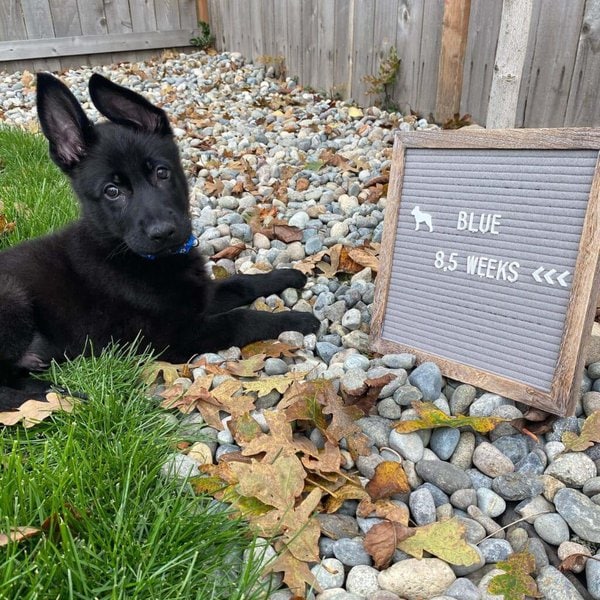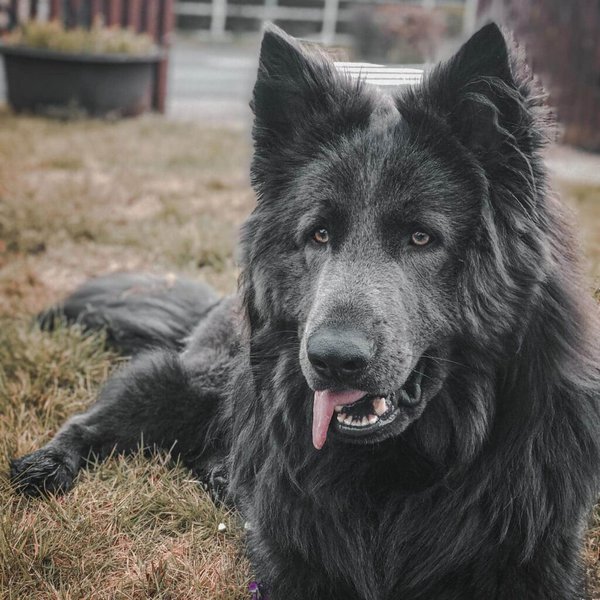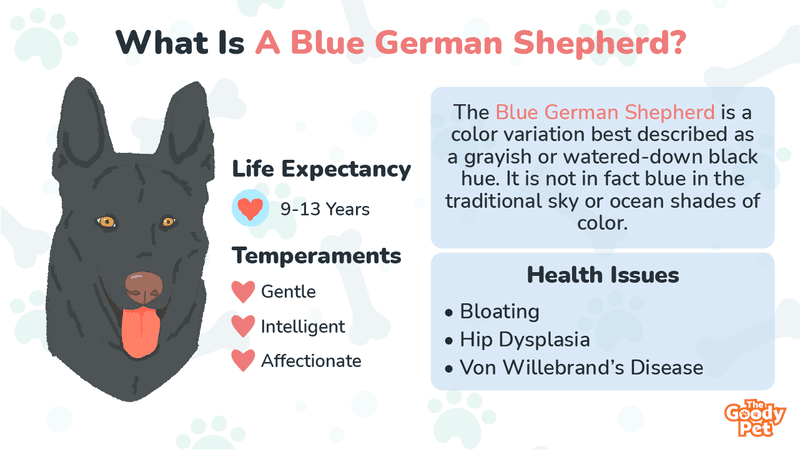Most people are only familiar with the iconic Black and Tan German Shepherd. However, there are so many other variations of the breed based on coat colors just waiting to be discovered and appreciated. The Blue German Shepherd is one of the rarest and most beautiful of these.
The Blue German Shepherd is a color variation best described as a grayish or watered-down black hue. It is not, in fact, blue in the traditional sky or ocean shades of color. The blue coat of the Blue German Shepherd is further classified based on special markings and bi-color combinations with groups, like blue and tan and sable blue.
The Blue German Shepherd is quite similar to the standard breed in most ways. However, it does have its few quirks in terms of physical and temperament traits. Let’s take a look at these and all that you need to know before getting a Blue German Shepherd
Are Blue German Shepherds Rare?

The Blue German Shepherd is one of the rarest color variations of the breed.
However, it is technically not the rarest, with the likes of the Liver German Shepherd taking the cake on that one.
The Blue German Shepherd is actually a purebred dog that is in the same breed as the better-known standard Black and Tan variation. This means they are pretty much the same in terms of appearance, with only a few differences. Here are a few of these physical quirks.
Coat Color
Blue German Shepherds have a grayish tone that, in some light, may appear like a dark and powdery blue. In a real sense, what they have is a watered-down version of the solid black color.
This trait is a result of a recessive gene associated with the gene responsible for the black coat. It causes this blue fur to appear either alone or in combination with tan patches.
Eye Color
Another striking and beautiful feature about these doggies is the fact that blue German Shepherds usually have blue or green eyes at birth. More often than not, these change to amber or a light brown hue by the time they reach 6 months of age.
Build And Size
Another slight difference you may notice is that the Blue German Shepherd is larger than most other variations. They can weigh up to 90 pounds or even more and measure between 22 to 26 inches in height. However, these differences are negligible, especially with large standard German Shepherd dogs.
What Are Common Health Problems In Blue German Shepherds?

Like the common German Shepherd varieties, the Blue German Shepherd has a lifespan of 9 to 13 years.
Blue German Shepherds are strong dogs that can live a long and happy life if they are well taken care of, as most of their health issues are non-fatal. Here are some of the most common and what it all means for the Blue German Shepherd’s length and quality of life.
Bloating
This happens mainly as a result of gastric volvulus. It is a condition where the stomach twists on itself, thus blocking the passage of food further down along the gut.
The bloating causes great discomfort to the doggy and may be associated with vomiting, reduced appetite, and a distended abdomen.
If you suspect your pooch has this problem, it is definitely worth getting in touch with the vet.
Hip Dysplasia
Hip dysplasia is a fairly common joint condition among large dog breeds. Blue German Shepherds are not spared.
If anything, the large size of blue German Shepherds may prove to be a disadvantage causing more dramatic symptoms in pooches that have the condition.
The good news is that most reputable breeders selectively breed to avoid this condition in the breed, so it is not that common.
Degenerative Myelopathy
Degenerative myelopathy is a condition that causes progressive damage to the spinal cord. It is more common in German Shepherds, including the blue variant than any other breed. The degeneration affects the dog’s mobility over time and could even result in paralysis.
Von Willebrand’s Disease
This is a bleeding disorder common in many dog breeds, including German Shepherds. It usually goes unnoticed, especially with healthy Blue German Shepherds who have had no physical trauma or surgical procedures done on them.
How Much Does A Blue German Shepherd Cost?

On average, a regular and untrained Blue German Shepherd will cost $1,200 to $1,500. Trained ones could go for tens of thousands depending on the breeder, especially those meant for use as personal protection or used by law enforcement officers.
Even without the special training, Blue German Shepherds are still relatively pricey. Here are some of the possible reasons for this.
Blue German Shepherds Are Rare
As we have mentioned earlier, Blue German Shepherds are among the rarest kind of German Shepherds. This creates a niche demand with very few doggies to fill it.
As a result, breeders charge a pretty penny for a single puppy compared to regular GSD color pups that can go for as low as $500. In other words, blue German Shepherd puppies are about 3 times more expensive than a regular German Shepherd puppy.
Expensive To Breed
Another reason you may have to pay so much for a Blue German Shepherd is the fact that they are expensive to breed. You need 2 purebred Blue German Shepherds to get the desired trait. Due to how rare the dogs are, stud fees are quite high, which makes it pricey for the breeder and, by some extension, pricey for you.
Great Family Dogs
Blue German Shepherd Dogs are also expensive because they are worth it.
Blue German Shepherds are very versatile and will fit into any environment. They are particularly awesome companion dogs, especially in homes with young children. The social, intelligent, and loving pooch will fit right in and bring new life to any home.
This is not only a reason why Blue German Shepherds are expensive but also a reason why that price tag eventually won’t matter.
Are Blue German Shepherds Hard To Train? Temperaments Of Blue German Shepherds

Blue German Shepherds are pretty much the same as other common coat variations of the breed when it comes to temperament. They are very easy to train, whether it is housebreaking or special training for use as a personal protection pooch. Here are a few of the traits that make this possible and that make the German Shepherd pooch more than worth the investment.
Intelligent
Blue German Shepherds are just like your regular old GSD in terms of intelligence. These dogs are not only quick to grasp new concepts but are always responsive and eager to learn. This is why they are so popular in law enforcement applications, as they can be trained for anything from scent detection to attacks on command.
Gentle
Despite their large build and the fact that they can be very ferocious attack dogs if trained for the part, Blue German Shepherds are generally very gentle and laid-back dogs. They love the company of their human companions and get along very well with young children.
If they are raised together from when the dog was a young puppy, the Blue German Shepherd will also develop protective instincts over their human siblings.
Affectionate
Blue German Shepherds take the man’s best friend title very seriously and live to show their human companions as much love and loyalty as they can muster. These dogs, though independent, thrive on human company, whether it is a loud family or a solo individual setup.
Their affectionate nature is one of the reasons why they are often used as emotional and physical support dogs.
Do Blue German Shepherds Shed? Grooming Tips For Blue German Shepherds
Blue German Shepherd dogs have beautiful coats, and we are not just talking about the watered-down black hue. They usually have medium to long, thick coats that you will have a lot of fun running your fingers through. Unfortunately, they are not hypoallergenic and shed quite a lot.
Therefore, the aesthetics come at a price which is the doggy’s high-maintenance nature when it comes to grooming needs. Fortunately, with the right tools and a good schedule to work with, they should be pretty easy to take care of. Here are a few tips that will come in handy.
Deshed 3 To 4 Times A Week
Blue German Shepherds can shed either moderately or heavily.
One of the best ways to deal with this is by using a deshedding brush to get rid of loose fur at least 3 times a week. We recommend the FURminator Undercoat Tool, which is not only effective but also easy to use and easy to clean.
For those loose hairs that you don’t manage to get as well as other pet dander, an automatic vacuum cleaner like the iRobot Roomba i3+ is an absolute must-have for great results as well as convenience. Keeping your house clean when you are out working has never been easier.
Detangle Every Week Or Two
For long coat Blue German Shepherds, there is a huge risk of matting of the coat, especially with a lot of time outdoors. All you need to do to prevent this is to simply brush to detangle the fur every week or two. A sleeker or deshedding brush should do the trick.
Wash Them Every 6 To 8 Weeks
Blue German Shepherds don’t tend to smell bad, especially if they do not have any skin issues. you can therefore get away with a washing interval of up to 2 months. Just make sure to use high-quality products that not only cleanse but restore the coat in case of damage.
Paws & Pals 6-In-1 Oatmeal Dog Shampoo is arguably the best option for your pooch if you want to wash and condition the coat while also dealing with odors, irritation, and skin damage.
Related Questions
Why Does My German Shepherd Have Blue Skin? Your German Shepherd may appear blue as a result of genetics which is the case with Blue German Shepherds. Strictly speaking, the tone here is more of a grayish hue than sky-like shades of blue. Another reason your German Shepherd’s skin is blue could be due to cyanosis. You will notice this mainly on their tongues and gums.
What Is A Blue Bay Shepherd? A Blue Bay Shepherd is a dog developed by crossing wolf dogs and domestic breeds like the German Shepherd. They are known for their wolf-like aesthetics and the intelligence and social skills of domestic breeds, which is why they are so popular. The “bay” part of the name comes from Palm Bay, Florida, which is where this mix was developed.
What Does A Blue Sable German Shepherd Look Like? The Blue Sable German Shepherd is defined as having watered-down black tips on lighter strands, including brown or tan. The tip markings are a result of the sable trait. However, due to the watered-down nature of the black tone in Blue German Shepherds, the tips appear more of a dark blueish-gray.





